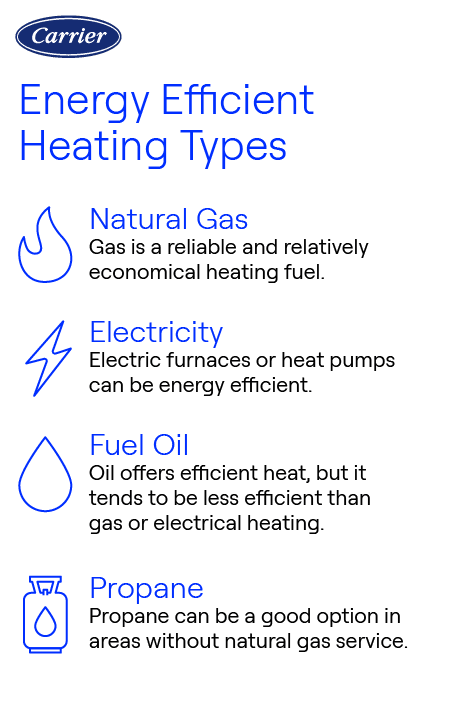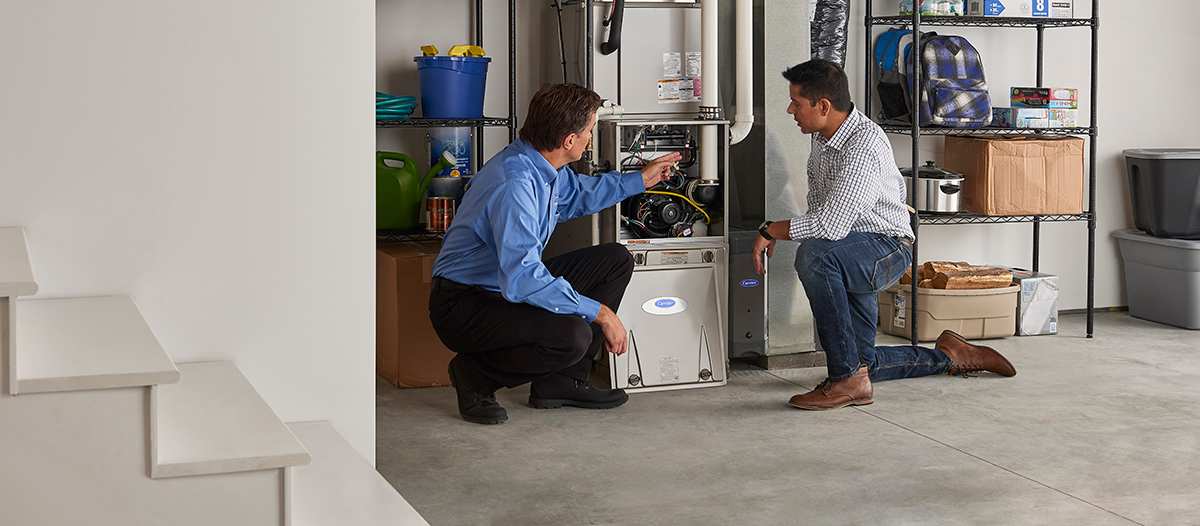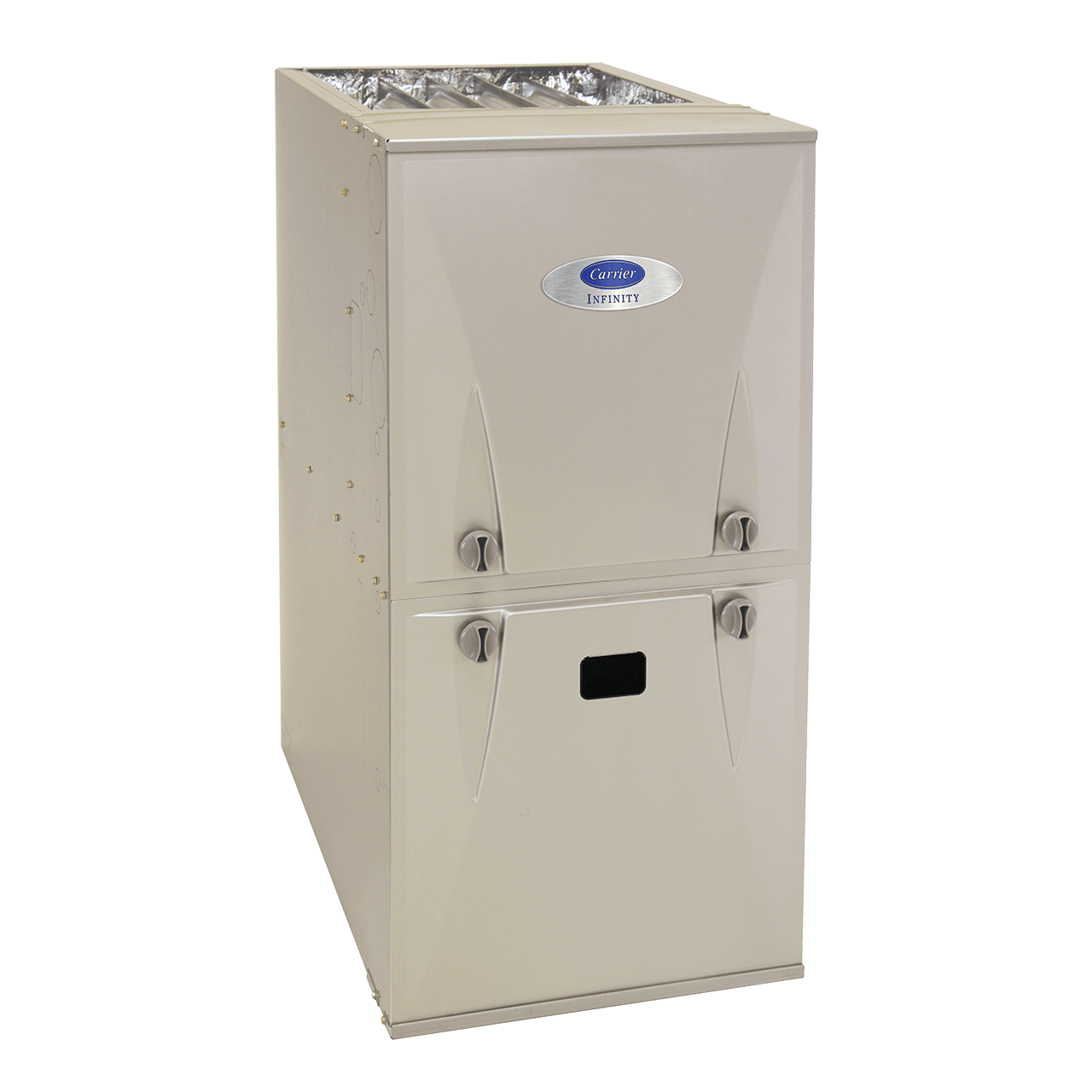Ready For a Gas Furnace Upgrade? Consider High Efficiency Furnaces
By Ryan Mayes
According to the Department of Energy, heating your home typically represents about 45% of your utility bill. [1] That’s a lot! And, that’s why there is so much interest in high efficiency furnaces and heating systems. When it comes to furnaces, “efficiency” refers to how effectively they can convert heating energy from a fuel source into warm, comfortable heat for your home. Today’s highest efficiency furnaces can provide comfort with up to 98.5% AFUE efficiency.

What are High Efficiency Furnaces?
A high efficiency gas furnace has AFUE ratings of 90% or higher, up to a maximum of 98.5% AFUE. AFUE stands for Annual Fuel Utilization Efficiency, and is a measure of how much heat the furnace can pull from the fuel it consumes, ultimately determining how energy efficient a heating and cooling system is. The AFUE of a furnace is determined by measuring the amount of heat in British Thermal Units (BTU) compared to the amount of fuel used during the same time period. The Department of Energy requires all manufactures to display a furnace’s efficiency on a yellow Energy Guide sticker on the unit, and most manufacturers will list the AFUE for each model they sell on their web sites and in printed materials. Efficiency standards are continually evolving, so today’s mid or high efficiency furnaces may be the future minimum efficiency model. You can learn more about furnace efficiency on our dedicated AFUE page.
THE BENEFITS OF HAVING A HIGH EFFICIENCY GAS FURNACE
Kevin Dickson, president of Energy Services Air Conditioning, Heating and Electrical in Naperville, Illinois, explains the major selling points of high-efficiency furnaces for homeowners.
“The top reason that a homeowner should consider a high-efficiency furnace is the potential for energy savings, which means lower heating bills”, Dickson said. “High-efficiency furnaces also provide additional safety due to the sealed combustion that brings in outdoor air. They also often qualify for rebates with local utility companies.”
Having an efficient heating system can offer great appeal to homeowners interested in having the most recent technology available, while potentially reducing energy costs and environmental impact. Because these models do such a great job at converting fuel into heat, less heating fuel is needed for comfort, resulting in less emissions. Additionally, in many cases our Carrier high efficiency furnaces also include technology that can produce enhanced comfort benefits and quieter operation.
Regardless of which benefit appeals to you the most, we’ve come a long way from the days of 56 – 70% AFUE efficiency, older furnaces that wouldn’t even meet the Department of Energy’s current minimum requirement. As you consider your options, keep in mind that generally, furnaces that deliver higher efficiency heating often come with higher price tags as well. That initial price difference should be at least partially offset by reduced heating bills over the life of your new heating equipment. Also, keep in mind that this article discusses and compares select fuel sources. Other heating systems, such as air-source heat pumps and geothermal systems, operate on different principles and therefore aren’t covered in this article. Learn more about a heat pump vs. furnace.
ARE HIGH EFFICIENCY GAS FURNACES WORTH UPGRADING TO?
Depending upon its age and condition, replacing your old heating equipment with a new, high efficiency gas furnace might make a lot of sense. Your older heating system may be operating at 56 – 70% AFUE efficiency, which is quite a bit less than today’s minimum efficiency standard of 80% AFUE. Today’s high efficiency models are available in the 90 – 98.5% AFUE range. Because heating your home is most likely the largest single expense attached to your utility bill, upgrading to a high efficiency gas furnace might be a great idea.
A higher efficiency gas furnace can save you money on energy bills over the life of your furnace. A new system with new product warranties should offer higher reliability and fewer costly furnace service calls compared to an older system for the first several years. Your older system, by comparison, will continue to operate at lower energy efficiency, potentially offer fewer comfort-enhancing features, and is more likely to falter during a cold snap, leaving you inconvenienced, uncomfortable, and potentially looking at a high repair bill.
Of course, as you consider your options, you’ll want to look into the cost of a new furnace, have a reputable HVAC contractor estimate energy costs compared to your older system, and also factor in potential service costs for repairing an aging system.

WHAT AFUE RATING CAN I EXPECT FROM THE HIGHEST EFFICIENCY OIL FURNACE?
High efficiency oil furnaces can cost less to operate per BTU generated than other furnace types, however they can typically only get a top AFUE rating of about 86.6%. When compared to 100% AFUE ratings for electric furnaces, or 90 - 98.5% AFUE ratings for natural gas furnaces, oil furnaces are not as efficient, but can be a good option, depending on where you live. Parts of the United States and other countries don’t have access to natural gas at the levels that other places have, and therefore opting to go with the highest efficiency oil furnace may be a good option.
Energy Efficient Heating Types

Forced air furnaces are available using four different fuels sources – natural gas, fuel oil, propane, and electricity. In general, they all work on the same principle:
- Heat from a fuel source is extracted in a heat exchanger or heating element inside the furnace.
- Air circulates from the home or outside, into the furnace and across the heat exchanger or heating element, where it absorbs the heat, raising the temperature of the air.
- The heated air is delivered to the home’s living spaces through a series of ducts and vents throughout the home.
Here is a look at the four types of heating systems and how they compare:
Natural Gas Furnace
As reported by the United States Department of Energy, natural gas is the most commonly used heating source in the United States [2] , and there is a good reason why. It is available in many areas and natural gas is generally the least expensive fuel source in terms of dollars spent per BTUs generated. So high efficiency, 90 – 98.5% AFUE natural gas furnaces can have lower monthly heating costs. However, not every home in the United States has access to natural gas, so homeowners in those areas rely on fuel oil, propane or electricity for their forced air heating systems. For a look at different types of gas furnaces available, be sure to look up Carrier gas furnaces to see a comprehensive selection available to match a wide variety of consumer needs and budgets.
Electricity
The U.S. Department of Energy shows electricity as the second most commonly used heating fuel2 but that includes all varieties of heating equipment, such as electric resistance heaters and heat pumps. Electric furnaces are considered to be 100% efficient, but that number is deceiving due to the low (about 30%) efficiency of producing the electricity, as well as transmission loss in electric lines. Electricity is almost universally available, but electric heat is typically more expensive than heat generated by natural gas, propane or fuel oil furnaces. That is due in part to the amount of electricity required to produce the heating output needed for comfort.
Fuel Oil
Fuel oil furnaces are quite a bit less common in the United States than natural gas models, and are typically found in concentrated areas of the Northeast United States and where natural gas availability is limited. Top efficiency for oil furnaces is currently around 86.6% AFUE, so these models don’t have the higher efficiencies that are available with natural gas. Newer oil furnaces may allow you to combine biodiesel with fuel oil to create a cleaner burning fuel mixture. Compared to propane and electric furnaces, fuel oil models may cost less to operate per BTU generated. Oil furnaces require an oil storage tank at your home and periodic oil delivery versus natural gas, which is delivered through a pipeline network.
Propane Furnaces
While propane furnaces may be the least common among the fossil-fuel options, propane furnaces generally offer high efficiency performance. Carrier does not manufacture dedicated propane furnace models, but all Carrier furnaces, with all of their available comfort-enhancing features, can be converted by a professional, certified technician for use with propane. Propane may cost a little more per BTU produced, but propane itself is inexpensive and considered to be cleaner burning than fuel oil and natural gas. Propane also requires a storage tank and periodic delivery versus natural gas, which is delivered through a pipeline network.
Gas Furnace Upgrades: Features of High Efficient Furnaces
High efficiency furnaces squeeze extra heat from the fuel they use by including technology and components not found on standard models. What are some of the gas furnace upgrades you can expect from a high efficiency furnace? At the highest end of the spectrum, Carrier gas furnaces with Greenspeed® intelligence combine features like variable-speed blower motors, a multi-stage modulating gas valve and patented electronic controls to adjust the furnace’s heating capacity to match current temperature and humidity conditions. Our ComfortFan™ technology allows you to select furnace fan speeds from the Infinity System Control. These are among the quietest and most energy efficient models we offer. Other technologies found in these furnaces include the ability to work with your cooling system to help reduce indoor humidity during the summer months, sealed combustion systems that pull air from outside for combustion and two-stage heating. Strip out some of the fancy features and you can still get a 90% AFUE furnace. That’s because to achieve 90% AFUE, a furnace will use two heat exchangers. The primary heat exchanger draws out the first 80% efficiency while a secondary heat exchanger pulls from the remaining usable heating energy from combustion to achieve 90% or better efficiency.
Carrier offers a full range of furnaces that can be installed and maintained by a local Carrier furnace expert. Schedule an appointment today for a gas furnace upgrade or furnace maintenance for your home.

Frequently Asked Questions About High Efficiency Furnaces
Standard-efficiency furnaces have an Annual Fuel Utilization Efficiency (AFUE) of 80%, meaning they convert 80% of gas energy into heat and waste the remaining 20%. High-efficiency furnaces have an AFUE of 90–97% or higher, depending on the model.
The installed cost of a new furnace can range from $3,800 -$12,000. For a high-efficiency model, you can expect to pay on the higher end of that scale. However, a higher efficiency furnace can help save you more money on your long-term operating costs.
According to the Department of Energy, if you replaced an 80% efficient furnace with a 95% efficient model, you could save $73 annually on your energy costs.3 High-efficiency furnaces may also be eligible for federal tax credits and local utility rebates. To calculate the payback on a high-efficiency furnace, you would need to subtract those rebates from the installed cost of the furnace and divide that number by the estimated annual energy cost savings.
Explore Carrier Furnaces
Choosing a Carrier furnace ensures reliable and efficient heating for your home, with advanced technology that optimizes energy use and enhances comfort. Known for their durability and quiet operation, Carrier furnaces provide consistent warmth throughout the winter while helping to reduce heating costs. Explore Carrier's line of furnaces today.
ENERGY STAR® certified. Our highest efficiency and most advanced furnace with up to 98.5% AFUE for premium energy savings with excellent humidity control and premium comfort
ENERGY STAR® certified. Up to 97.0% AFUE for premium energy savings with enhanced comfort features.
All sizes ENERGY STAR® certified. Up to 97% AFUE for premium energy savings with standard comfort features.
Learn More About Gas Furnace Upgrades
- How long does a furnace last?
- Learn about changing furnace filters
- What is the cost of furnace replacement vs repair
- Learn about cleaning a furnace
- Learn about furnace installation and gas furnace installation
- Read more about comparing types of furnaces




